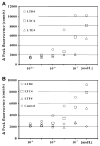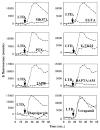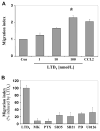Leukotriene D(4) induces gene expression in human monocytes through cysteinyl leukotriene type I receptor
- PMID: 18028998
- PMCID: PMC5560436
- DOI: 10.1016/j.jaci.2007.09.013
Leukotriene D(4) induces gene expression in human monocytes through cysteinyl leukotriene type I receptor
Abstract
Background: Cysteinyl leukotrienes (CysLTs) are important mediators of innate immune responsiveness and chronic inflammatory diseases. CysLTs acting through CysLT receptors can influence the migration and activity of cells, such as eosinophils, monocytes, and dendritic cells.
Objective: We sought to determine the gene expression signature of human monocytes in response to CysLTs and to elucidate the signaling pathways involved in monocyte activation.
Methods: Gene expression was analyzed by using oligonucleotide microarrays. Responsiveness to CysLTs was assessed by using real-time PCR, calcium flux, kinase activation, and chemotaxis assays.
Results: CysLT type 1 receptor (CysLTR(1)) transcript 1 is predominantly expressed in human monocytes, and CysLTs signal through CysLTR(1) in these cells. Several immediate-early genes, including early growth response 2 and 3, FBJ murine osteosarcoma viral oncogene homolog B, activating transcription factor 3, and nuclear receptor subfamily 4 were significantly induced by leukotriene (LT) D(4). This effect was mediated by CysLTR(1) coupled to the G protein alpha inhibitory subunit, activation of phospholipase C, and inositol-1,4,5-triphosphate and store-operated calcium channels. LTD(4) induced p38 mitogen-activated protein kinase phosphorylation, a pathway also involved in the regulation of immediate-early gene expression in monocytes. LTD(4) stimulated monocyte chemotactic activity that was fully blocked by a selective CysLTR(1) inhibitor, MK571, and pertussis toxin, suggesting that CysLTR(1) coupled to the G protein alpha inhibitory subunit is a dominant functional pathway in human monocytes.
Conclusion: Our data show that CysLTs acting through CysLTR(1) can significantly influence the activation and migration of human monocytes and that these effects can be fully inhibited by CysLTR(1) antagonists.
Conflict of interest statement
Disclosure of potential conflict of interest: The authors have declared that they have no conflict of interest.
Figures






References
-
- Gordon S, Taylor PR. Monocyte and macrophage heterogeneity. Nat Rev Immunol. 2005;5:953–64. - PubMed
-
- Romagnani P, Annunziato F, Liotta F, Lazzeri E, Mazzinghi B, Frosali F, et al. CD14+CD34low cells with stem cell phenotypic and functional features are the major source of circulating endothelial progenitors. Circ Res. 2005;97:314–22. - PubMed
-
- Kanaoka Y, Boyce JA. Cysteinyl leukotrienes and their receptors: cellular distribution and function in immune and inflammatory responses. J Immunol. 2004;173:1503–10. - PubMed
-
- Peters-Golden M, Canetti C, Mancuso P, Coffey MJ. Leukotrienes: under-appreciated mediators of innate immune responses. J Immunol. 2005;174:589–94. - PubMed
MeSH terms
Substances
Grants and funding
LinkOut - more resources
Full Text Sources
Molecular Biology Databases

